Architecture
Sensual Serenity
“Simplicity at this best”- this perfectly describes the residence of Mr. Suresh Panicker & Meena. You can see a blend of traditionalism as well as modernism in this house designed by Architect Punnen C. Mathew of Design Combine Architects & Designers, Kakkanad, Cochin.
“Simplicity at this best”- this perfectly describes the residence of Mr. Suresh Panicker & Meena. You can see a blend of traditionalism as well as modernism in this house designed by Architect Punnen C. Mathew of Design Combine Architects & Designers, Kakkanad, Cochin.
The house is located within the cramped urban limits at Thiruvananthapuram. But when explaining the requirement, the well travelled client’s demand was to create maximum space effect within the limits. Mr.Mathew achieved this by an uncluttered open house with an earthly warmth.
Design Concept
The house was designed for a family of 4. “As any typical Keralite requirement, the spaces must cater to the requirements of accommodating an extended family temporarily or permanently” says Mr. Mathew. The house again is located at the end of a 3m wide road, which made it necessary to treat the front of the house in a way that it looks broader and at the same time with enough privacy. The entrance faces the West, which created the requirement of working on fenestrations to cut off evening sun. This was achieved by maintaining minimum openings towards the west and with judicious use of sun shading louvers and sun breakers.
Although the house is based on a global design language, it is built using conventional building materials, which are cost effective and efficient. Along with maximum space utilisation, a spacious effect was created by having the core of the house -its living spaces connected at various levels as a single space. “This creates an illusion of a large heart to the house”, says Mr. Mathew. “The longitudinal spaces in the living spaces also visually enlarge a space”.
Interiors and Colour Scheme
The over all design is open. The spaces are left with no clutters and with a classic underlying theme to ensure longevity.
As per both local and international standards, earthy looks can be created by warm tones. Light tones are also fabulous and it works well with woody tones. Neutral colours always make a room seem costlier and all others colous and accessories will have a stunning accent along with the dominant light interior. These concepts have been applied here.
Also it is a common trend over the years to go back to the past as a reference point. No matter what ever the style you are adapting, a little touch of vintage glamour makes a bold style statement.
Spaces Inside
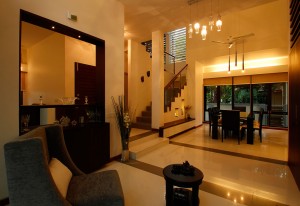 Formal Living- The formal living is ‘classy’ and enriched with the beauty of plainness. Large French windows with no grills create a sense of openness, and at the same time blinds ensure the required privacy. The living space like all the other spaces is well ventilated too to ensure that ample natural light is coming in. Indirect lighting gives a formal look and blends with the specially designed classy sofas.
Formal Living- The formal living is ‘classy’ and enriched with the beauty of plainness. Large French windows with no grills create a sense of openness, and at the same time blinds ensure the required privacy. The living space like all the other spaces is well ventilated too to ensure that ample natural light is coming in. Indirect lighting gives a formal look and blends with the specially designed classy sofas.
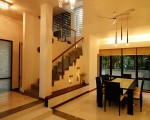 The Central Space-The central space that connects the living and dining spaces is the heart of this house. All the living spaces are connected by a compact staircase. The double – two and a half height space here also enhances the feeling of a large house, while bringing in a lot of light and ventilation to the centre.
The Central Space-The central space that connects the living and dining spaces is the heart of this house. All the living spaces are connected by a compact staircase. The double – two and a half height space here also enhances the feeling of a large house, while bringing in a lot of light and ventilation to the centre.
The central space also justifies the traditional idea of courtyard house, where the sky lit courtyard would form the central light and ventilation source of the house. The connected character of the living spaces as well as the compact open kitchen caters to the new urban living of a working ‘woman of the house’. It reduces the distance between functions and thus increases the efficiency of the living core.
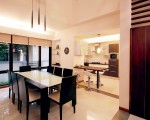 Dining Area -The dining area is a horizontal space with natural light peeping in from the side window as well as the central courtyard. The family living close to dining ensures more interactive spaces for the family members.
Dining Area -The dining area is a horizontal space with natural light peeping in from the side window as well as the central courtyard. The family living close to dining ensures more interactive spaces for the family members.
 Bedrooms-A hard day’s work must be followed by a blissful night of sleep. All bedrooms are cozy and cross ventilated. All the three bedrooms are attached and have a balcony which is opened from a wall cum windows of glass with no rails. The toilets are designed in a way that it has enough light and ventilation with the use of louvers and glazing. This also creates a feeling of ‘bigger’ than they actually are.
Bedrooms-A hard day’s work must be followed by a blissful night of sleep. All bedrooms are cozy and cross ventilated. All the three bedrooms are attached and have a balcony which is opened from a wall cum windows of glass with no rails. The toilets are designed in a way that it has enough light and ventilation with the use of louvers and glazing. This also creates a feeling of ‘bigger’ than they actually are.
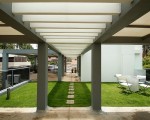 Terrace-This is the most envious spot in the entire house. Enhanced with a terrace garden with buffalo lawns and gathering space with seating, it is a perfect spot party cum hang out space. When converting the terrace to an usable space, a membrane roof shading was created, which doubles up as a roof shading for the main building, thus not only giving rain protection to the terrace, but also keeping the roof protected from direct sun rays, effectively reducing the heat intake of the building.
Terrace-This is the most envious spot in the entire house. Enhanced with a terrace garden with buffalo lawns and gathering space with seating, it is a perfect spot party cum hang out space. When converting the terrace to an usable space, a membrane roof shading was created, which doubles up as a roof shading for the main building, thus not only giving rain protection to the terrace, but also keeping the roof protected from direct sun rays, effectively reducing the heat intake of the building.
“Enjoying spaciousness within the urban compactness and a simplicity that’s been inspired by nature”, the architect sums up his pursuit.
Architecture
Creating a Cozy Living Room: Tips for Comfort and Style
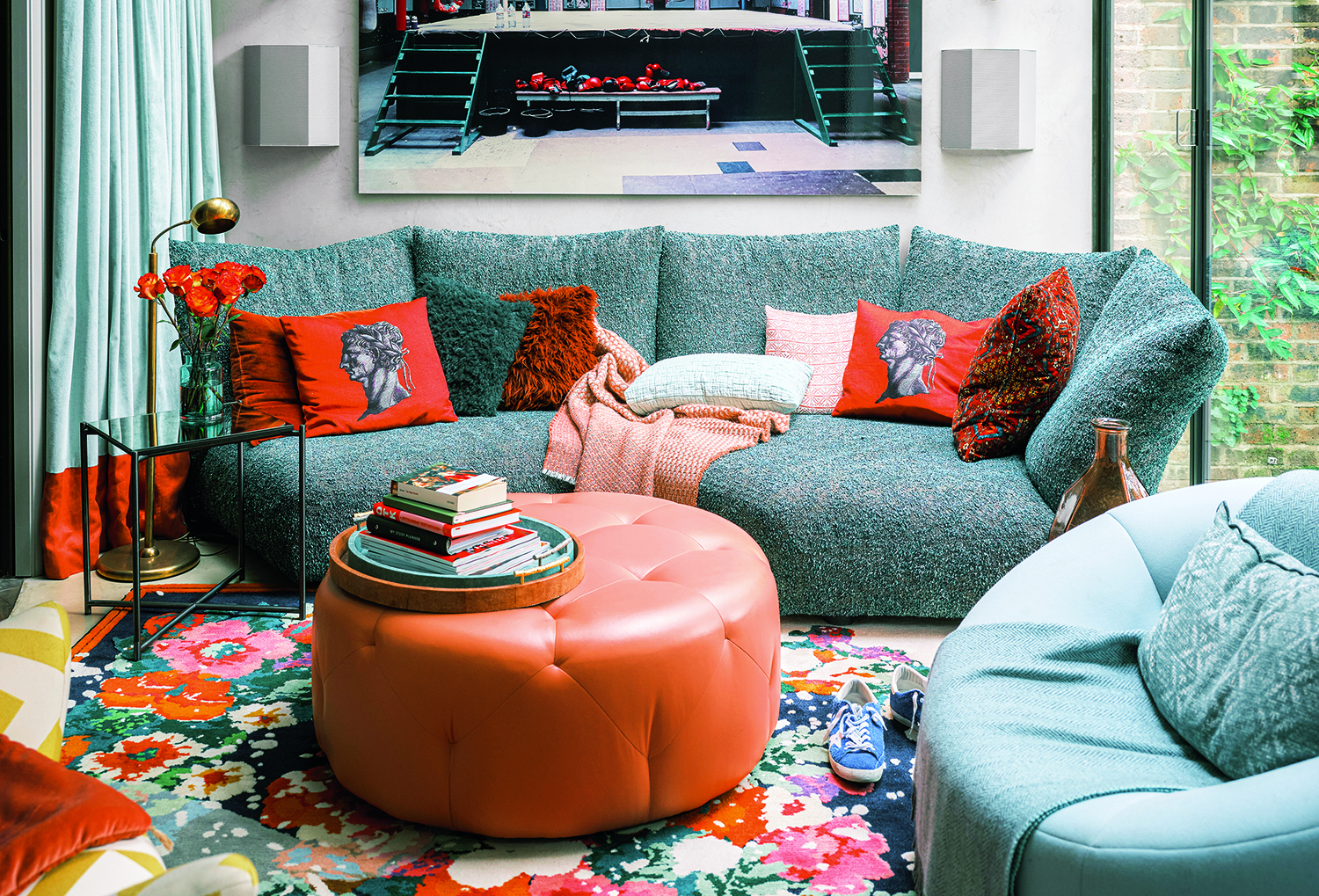
Your living room is more than just a space for entertaining; it’s a sanctuary where you unwind, relax, and spend quality time with loved ones. Creating a cozy living room involves a blend of comfort and style that makes the space inviting and functional. Here are some tips to help you achieve that perfect balance:
Choose the Right Furniture
Start with furniture that combines comfort and functionality. Opt for a plush sofa with deep cushions, perfect for lounging. Consider adding a cozy armchair or a recliner for additional seating. Make sure the furniture arrangement promotes conversation and allows for easy movement throughout the room.
Layer Your Lighting

Lighting plays a crucial role in setting the mood. Use a mix of lighting sources to create a warm ambiance. Combine overhead lights with floor lamps, table lamps, and wall sconces. For added coziness, incorporate dimmers or smart bulbs that let you adjust the brightness to suit different times of day and activities.
Add Textures with Throws and Pillows
Textures are key to a cozy living room. Layer different fabrics, such as soft throw blankets, plush pillows, and textured rugs. Choose fabrics like wool, velvet, and cotton that add warmth and comfort. Mix and match patterns and colors to create visual interest and a personalized touch.
Incorporate Warm Colors
Color influences the feel of a room. Opt for warm, neutral tones like beige, taupe, or soft gray for a calming effect. Accents in rich colors like deep blues, earthy greens, or warm terracotta can add depth and coziness. Use these colors in your furniture, accessories, and wall decor.
Use Rugs to Define Spaces
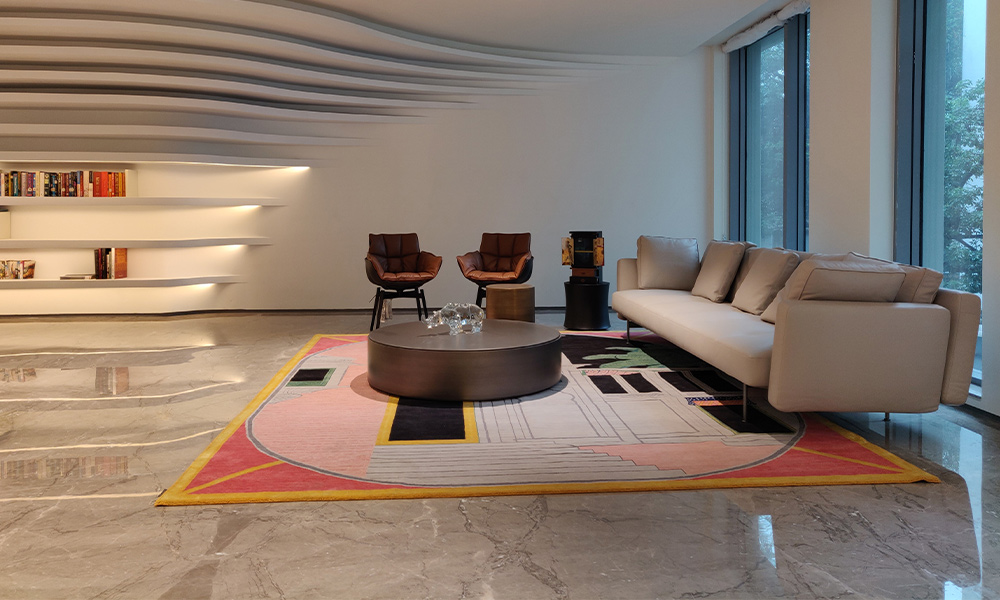
Rugs can help define different areas within a living room and add a layer of warmth underfoot. Choose a rug that complements your furniture and adds softness to the space. A large area rug can anchor the room, while smaller rugs can be used to highlight specific areas, like a reading nook or conversation zone.
Incorporate Natural Elements
Bring the outdoors in by incorporating natural elements. Plants not only add a touch of greenery but also improve air quality and create a calming atmosphere. Choose low-maintenance plants like succulents or snake plants if you’re not an avid gardener. Wooden furniture or decor pieces can also add a natural, grounded feel to the room.
Personalize with Artwork and Décor
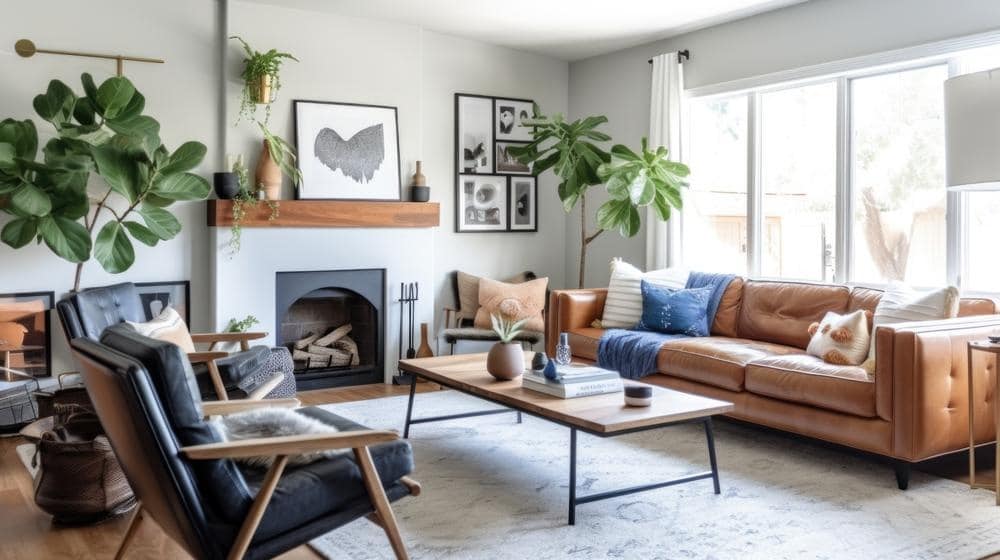
Add personality to your living room with artwork and decorative items that reflect your style. Choose pieces that resonate with you, whether it’s family photos, abstract art, or vintage finds. Arrange decor items in groups to create visual interest and avoid clutter.
Create a Focal Point
A focal point helps draw the eye and creates a sense of balance in the room. This could be a fireplace, a statement piece of art, or a stylish coffee table. Arrange your furniture and decor around this focal point to enhance the room’s overall cohesion and appeal.
Invest in Quality Window Treatments
Window treatments can impact both the look and feel of your living room. Opt for curtains or blinds that provide privacy while allowing natural light to filter through. Choose fabrics that complement your decor and add texture, such as linen or velvet.
Add Personal Touches
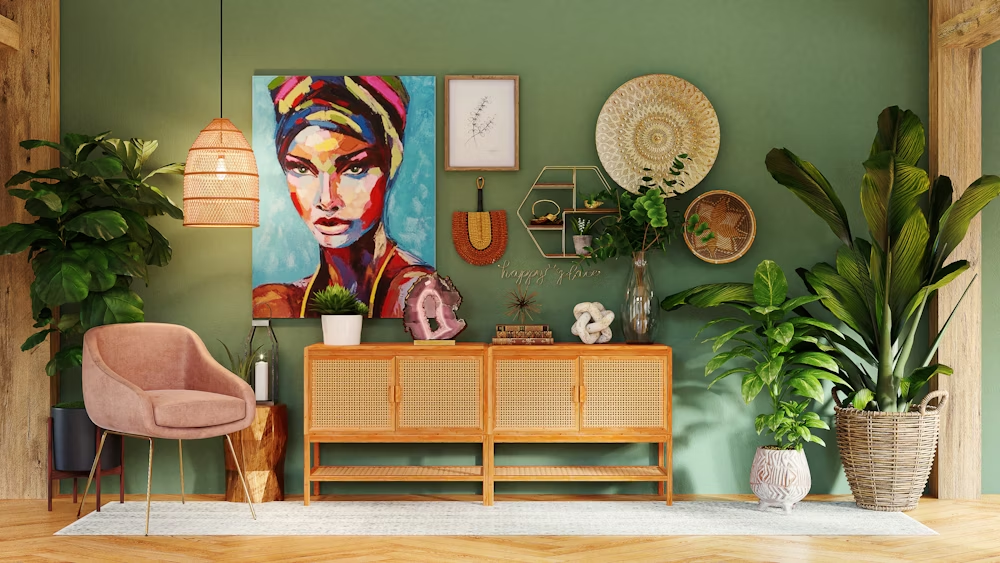
Finally, make the space truly yours by adding personal touches. Incorporate items that have sentimental value or reflect your interests and hobbies. Whether it’s a collection of travel souvenirs, a beloved quilt, or unique decorative objects, these elements will make your living room feel more inviting and personal.
By thoughtfully combining these elements, you can create a cozy living room that serves as a comfortable retreat and a stylish gathering place for friends and family. Enjoy the process of making your space uniquely yours and revel in the comfort and warmth it provides.
Architecture
The Art of Feng Shui: Creating Harmony in Your Home

Feng Shui, an ancient Chinese art and science, is all about creating harmony and balance in our living spaces. By arranging our homes in accordance with Feng Shui principles, we can invite positive energy, known as “chi,” into our lives and promote health, wealth, and happiness. In this blog post, we’ll explore the fundamentals of Feng Shui and share practical tips for applying its principles to create a harmonious and inviting home environment.
Understanding the Basics of Feng Shui:
Feng Shui is based on the concept of “chi,” or life force energy, which flows through our environments and influences our well-being. The goal of Feng Shui is to create a harmonious flow of chi by arranging our surroundings in a way that promotes balance and harmony. This includes paying attention to the layout, orientation, and organization of our homes to optimize the flow of energy.
The Five Elements of Feng Shui:
In Feng Shui, there are five elements—wood, fire, earth, metal, and water—that represent different qualities and energies. By incorporating these elements into our home decor, we can create a sense of balance and harmony. For example, wood represents growth and vitality, while water symbolizes flow and abundance. By incorporating a balance of these elements into our living spaces, we can enhance the flow of positive energy and create a sense of equilibrium.
Applying Feng Shui Principles to Your Home:
Clearing Clutter: Clutter can block the flow of chi and create stagnant energy in our homes. Start by decluttering your space and getting rid of items that no longer serve a purpose. This will create space for fresh energy to flow and rejuvenate your home.
Balancing Yin and Yang: In Feng Shui, yin and yang represent the balance of feminine and masculine energies. Create a harmonious balance of yin and yang in your home by incorporating soft, nurturing elements (yin) with strong, active elements (yang).
Enhancing the Flow of Chi: Pay attention to the layout and arrangement of furniture in your home to optimize the flow of chi. Avoid placing furniture in direct line with doorways or blocking pathways, as this can disrupt the flow of energy. Instead, create open and inviting spaces that allow chi to circulate freely.
Incorporating Nature: Bring the outdoors in by incorporating elements of nature into your home decor. Plants, natural materials, and natural light can enhance the flow of chi and create a sense of vitality and well-being in your living spaces.
Room-By-Room Feng Shui Tips:
Living Room: Arrange furniture in a circular or semi-circular layout to encourage conversation and social interaction. Use soft, natural fabrics and incorporate elements of wood and fire to create warmth and intimacy.
Bedroom: Position your bed diagonally across from the door to command a clear view of the room while you sleep. Keep the space under your bed clear and clutter-free to promote restful sleep and relaxation.
Kitchen: Keep your kitchen clean, organized, and clutter-free to promote health and abundance. Incorporate elements of fire and earth, such as candles and earthy tones, to create a warm and inviting atmosphere for cooking and dining.
By incorporating the principles of Feng Shui into your home decor, you can create a harmonious and balanced living environment that supports your health, happiness, and overall well-being. Whether you’re decluttering your space, balancing yin and yang energies, or enhancing the flow of chi, the art of Feng Shui offers timeless wisdom and practical guidance for creating a sanctuary of peace and tranquility in your home.
Architecture
5 Sustainable Interior Design Trends to Embrace in 2024
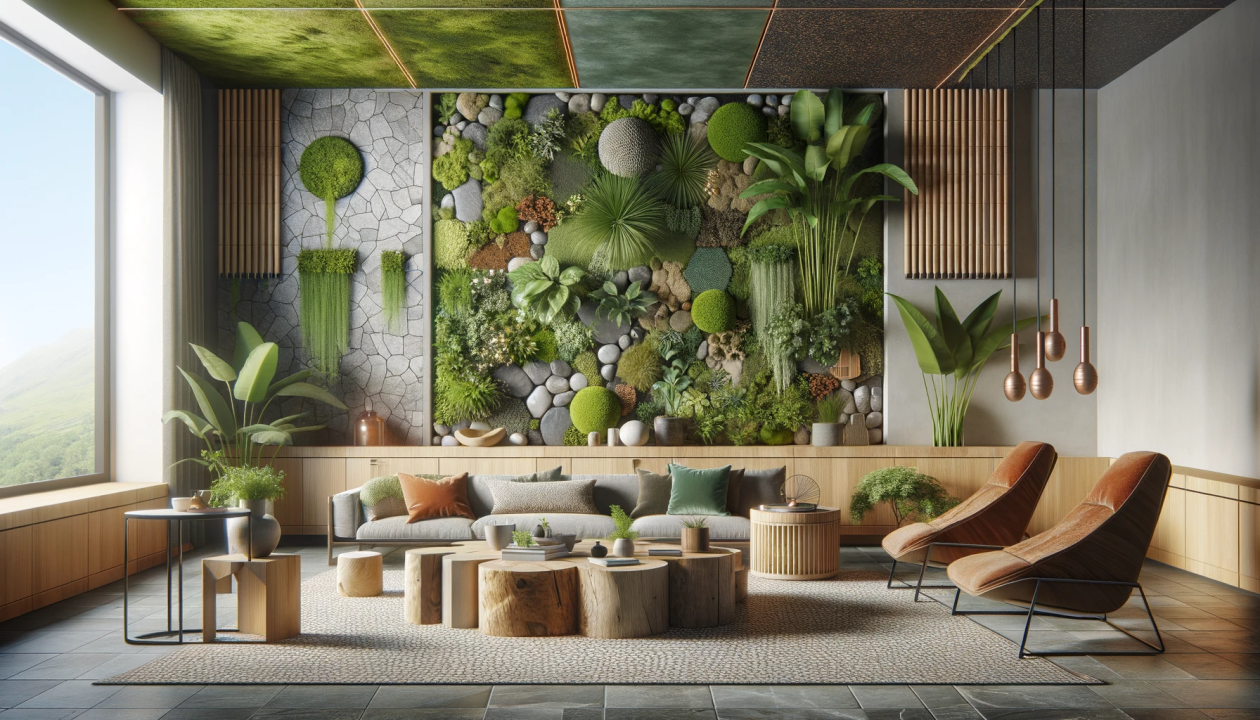
As the world becomes increasingly aware of the importance of sustainability, it’s no surprise that eco-friendly practices are making their way into the realm of interior design. In 2024, we can expect to see a surge in sustainable interior design trends that not only enhance the beauty of our living spaces but also minimise our environmental footprint. From repurposed materials to energy-efficient solutions, here are five sustainable interior design trends to embrace this year.
Upcycled Furniture:
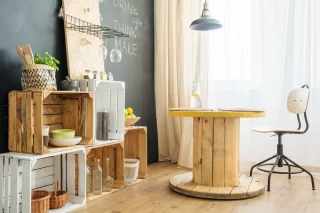
One of the most prominent sustainable interior design trends of 2024 is the use of upcycled furniture. Instead of buying new pieces, consider giving old furniture a new lease on life by refurbishing or repurposing them. From reclaimed wood tables to refurbished chairs, upcycled furniture adds character and charm to your space while reducing waste and conserving resources.
Biophilic Design:

Biophilic design, which emphasizes a connection to nature, continues to gain popularity in 2024. Integrating natural elements such as plants, natural light, and organic materials into your interior design not only enhances aesthetics but also promotes well-being and sustainability. Consider incorporating living walls, indoor gardens, and sustainable wood finishes to bring the outdoors inside and create a healthier living environment.
Energy-Efficient Lighting:

With a growing focus on energy conservation, energy-efficient lighting solutions are becoming a staple in sustainable interior design. LED lights, in particular, consume significantly less energy than traditional incandescent bulbs and last much longer, reducing both energy consumption and maintenance costs. Additionally, consider incorporating natural light sources such as skylights and large windows to maximize daylight and minimize the need for artificial lighting during the day.
Sustainable Textiles:

When it comes to upholstery and soft furnishings, opting for sustainable textiles is key to reducing environmental impact. Look for fabrics made from organic or recycled materials, such as organic cotton, hemp, bamboo, or recycled polyester. These materials not only reduce the use of harmful chemicals and pesticides but also minimize waste and support eco-friendly production practices. Additionally, consider investing in durable, high-quality textiles that stand the test of time, reducing the need for frequent replacements.
Smart Home Technology:

In 2024, smart home technology continues to evolve, offering innovative solutions for sustainable living. From smart thermostats that optimize energy usage to home automation systems that control lighting and appliances, these technologies can help reduce energy consumption and increase efficiency in your home. Additionally, smart home devices such as occupancy sensors and smart meters provide valuable insights into your energy usage, empowering you to make informed decisions about resource management and conservation.
As we strive to create more sustainable living environments, embracing these five interior design trends can help reduce our environmental impact while creating beautiful and functional spaces. Whether you’re upcycling old furniture, incorporating natural elements, or investing in energy-efficient technologies, every sustainable choice contributes to a greener future for generations to come. So let’s embrace these trends and make sustainability a cornerstone of our interior design practices in 2024 and beyond.
-

 Style11 months ago
Style11 months agoBridal Guide : Best Looks of Radhika Merchant Ambani
-

 Entertainment1 year ago
Entertainment1 year agoThe Stunning looks from Bhagya Suresh’s Wedding
-

 Fashion1 year ago
Fashion1 year agoMost Discussed Ajrakh Saree of Alia Bhatt
-

 Entertainment1 year ago
Entertainment1 year agoThe Most Stylish Guests of Bhagya Suresh Reception
-

 Entertainment1 year ago
Entertainment1 year agoBridal Bliss : All Bridal Looks of Swasika Vijay
-

 Movies1 year ago
Movies1 year agoA Nostalgic Journey Through Love &Cinema : Best Bollywood Romantic 90s Movies
-

 Fashion1 year ago
Fashion1 year agoMajor Denim Trends You Need To Know in 2024
-

 AD8 months ago
AD8 months agoPopular Curtain Fabrics to Consider for Your Home































